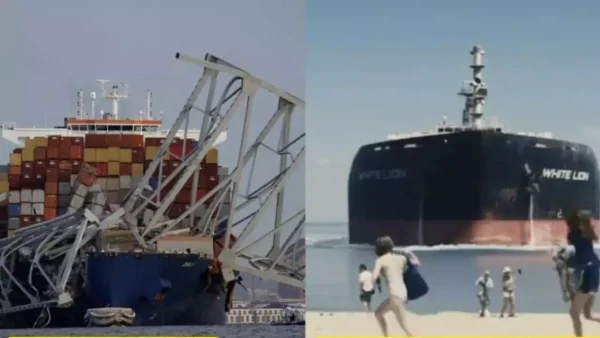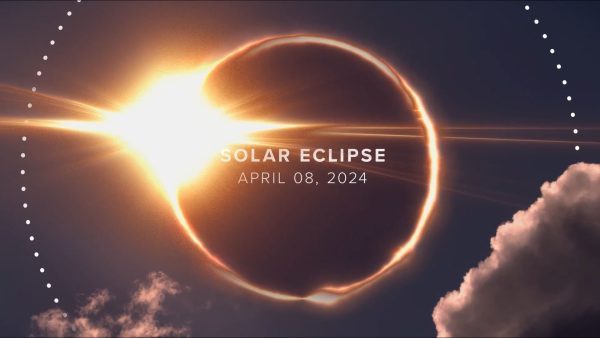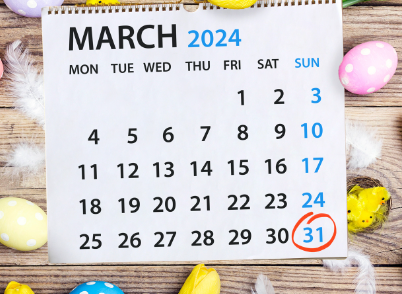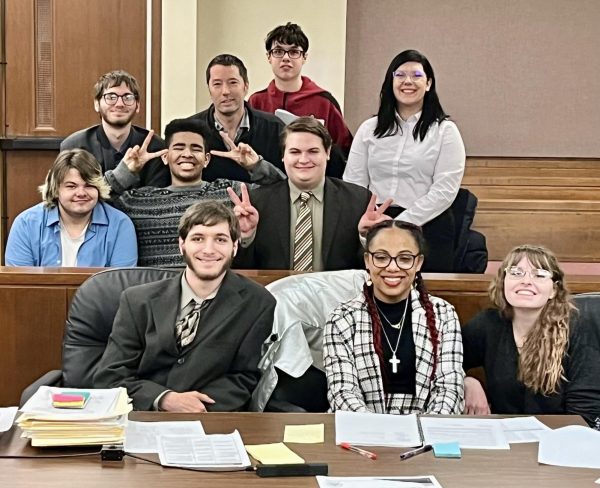How to Eliminate Dismissal Time Traffic Congestion
With a few changes, the traffic flow surrounding the school can be increased significantly.
Updated 10/22/2019
Many parents and students will agree that traffic during arrival and dismissal times can be frustrating. This year, sixth grade has been added to the high school, adding approximately 240 more students to the high school, in addition to faculty members. Traffic certainly has increased this year with this addition, as many of these sixth graders are not bused in as they are considered ‘walkers’, meaning they either have to walk home or have a family member pick them up from school. Sixth graders will arrive ten minutes before the students in upper grades and leave ten minutes after the upperclassmen. It seems that measures are going to need to put into place to help alleviate some of the congestion, as well as confusion, during these times.
In the past few years, traffic at the high school has been pretty bad, and numerous accidents have happened either on the roads surrounding the school or in the parking lots of the school. I am unsure as to what conditions led to such accidents, such as texting and driving, a simple distraction, or disobeying signs posted along the street. In addition to the accidents I have seen, I have also seen traffic backed up at least twenty cars deep originating at the intersection of Highland Avenue and Lincoln Avenue.
In the coming decade, I predict traffic surrounding the high school to get worse due to planned construction projects in the surrounding area. According to PennDOT’s 12-year Transportation Improvement Plan, major projects in New Castle will include the replacement of the East Washington Street Bridge, Repaving of East Washington Street, Repaving of Route 18, and numerous other state-owned roads throughout the city.
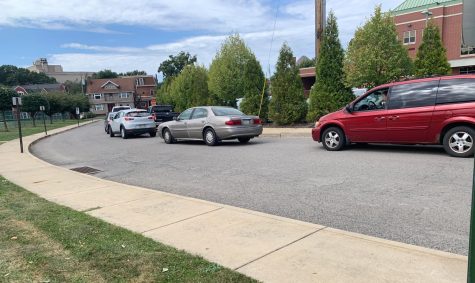

Many of the intersections surrounding the high school have been known to cause potentially confusing traffic conditions. These two intersections, in particular, East Street @ Hurricane Drive (pictured top), and Lincoln Avenue @ Highland Avenue (pictured bottom) have been causing some serious backups surrounding the high school these past few weeks. I have noticed that it has only been getting worse over time and no improvement plans exist. (License plates and people are blurred out in the images for privacy protection).
The Pennsylvania Department of Transportation has released information on crashes in the county for the past twenty years. Through the data I went through, between the years 2013 and 2018, I found the number of accidents, fatalities, and injuries at these intersections. The amount is surprisingly less than I thought it would be (some likely don’t get reported). Here is what I found. Keep in mind that these accidents are at all times during the year, and do not represent only accidents during arrival/dismissal times. There were no fatalities over these six years.
- Park Avenue @ Highland Avenue: 8 accidents, 9 injuries
- Boyles Avenue @ Highland Avenue: 1 accident, 0 injuries
- Reis Street @ Highland Avenue: 7 accidents, 6 injuries
- Wallace Avenue @ Highland Avenue: 8 accidents, 9 injuries
- Lincoln Avenue @ Highland Avenue: 5 accidents, 4 injuries
- Lincoln Avenue @ East Street: 2 accidents, 0 injuries
- Lincoln Avenue @ Centennial Street: 1 accident, 3 injuries
- Hurricane Drive @ East Street: 2 accidents, 2 injuries
- Falls Street @ Mill Street: 9 accidents, 10 injuries
- Falls Street @ East Street: 1 accident, 1 injury
- North Street @ East Street: 6 accidents, 3 injuries
In total, this accounts for at least 50 accidents at all of the major intersections surrounding the school in a 6-year timeframe, an average of 8 per year. In these accidents, there were 47 injuries. On top of this statistic, there are countless near-misses. Within a week, I almost got t-boned twice at the intersection of Lincoln Avenue @ Highland Avenue.
Researching a Solution
I decided to try to find a solution to this type of situation. The solution would have to be a cost-efficient, effective, and not able to back traffic up after school hours. I researched solutions other school districts across the country were doing to solve similar congestion issues, and the answer is surprisingly less costly than many might think.
I found that many schools across the country are beginning to utilize roundabouts to help solve these issues. Intersections like this have great benefits such as an increase in traffic safety, due to the low chance of the most severe type of crash; the head-on crash. A 2014 study conducted by the Minnesota Department of Transportation found that roundabouts reduced crashes by 30 percent and a 65 percent less chance for a crash with injuries. The biggest benefit for this type of intersection is that it provides a continuous flow of traffic, as drivers only have to yield upon entering, and once you are inside of the roundabout, you keep driving until you reach your point of exit. Another benefit is that it improves pedestrian crossing, as there is an improved sight-line, and in most roundabouts, drivers are required to yield to all pedestrians, which is great for schools. Another school-related benefit is that it helps prevent speeding in school zones, as drivers must slow down to safely navigate the intersection. The other benefit is that they generally give off a good aesthetic, with the center island allowing room for trees, statues, or anything you could want.
However, no intersection is perfect and there are cons in addition to the pros. The biggest con is that in some cases, it may be more expensive than a traffic signal, however long-term they cost less to maintain. This is due to it requiring more space than a traditional signalized intersection, which I don’t believe would cause much of an issue around the school, as much of the land needed is already owned by either the city, the state or the school district. Another con is that special considerations in the design must be in place for school buses and semi-trucks, as they have a significantly larger turning radius than cars. The final con is familiarity; a new roundabout can cause confusion in the short-term, especially in Western Pennsylvania, where roundabouts are very uncommon.
The truth is, roundabouts are becoming installed more rapidly in Western Pennsylvania now than they ever have been. Recently in the past year, a roundabout was installed in Sharon, two in Mahoning County, Ohio, and a dual-lane hybrid roundabout in Meadville. One is also planned on being built next year in Hermitage by the Shenango Valley Mall. As these are installed more throughout the region, the more drivers will be able to familiarize them. Roundabouts near the school could become good practice for behind-the-wheel driver’s education class, as they will likely be installed throughout the rest of the county as well in the coming years.
A roundabout at Pope High School in a suburb of Atlanta, Georgia is one I particularly researched, as satellite map imagery is available of this roundabout. The school has a similar size in comparison to New Castle High School, having around 1,800 students, compared to the approximately 1,500 students at our school. The main road this school is located on has an average traffic volume of 5,000 cars per day, according to the Georgia Department of Transportation. According to PennDOT, Highland Avenue near the school gets almost 10,000 cars per day, double the amount the school in Georgia has. I also presume that the school in Georgia buses all of its students, as there is a significant amount of bus parking spaces at the side of the school, lowering the number of cars at the school even more (I couldn’t find any information on this, however).
The Prototype Design
To help readers better understand the ideas I have to negate these issues, I created a prototype design. To create three-dimensional renders I used SketchUp Make 2017 to model the intersections, as well as Google Earth and Photoshop to edit in nearby buildings and realistic skies. Short disclaimer: I am in no way a professional engineer, I am just researching potential ways to make it easier to navigate the roads surrounding the school, and creating models to represent these ideas in a form of a picture.
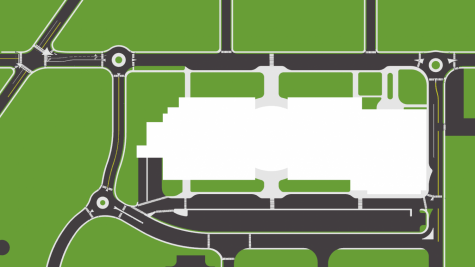
This is my prototype design for the area surrounding New Castle High School. As you can see in the image above, the first major change is that a traffic signal would be added to the intersection of Lincoln Avenue and Highland Avenue, with protected right-turn lanes from Lincoln Avenue onto Highland Avenue. There would be two lanes between the proposed single-lane roundabout at the intersection of Lincoln Avenue and East Street, one leading to the straight lane and right turn lane, and one leading to left turns onto Highland Avenue. Another roundabout would be located at the intersection of East Street and Hurricane Drive, and the parking lot would become one way only. A final roundabout would be installed at the intersection of Rhodes Place and Lincoln Avenue.
 Lincoln Avenue @ Highland Avenue: Traffic Light
Lincoln Avenue @ Highland Avenue: Traffic Light
Arguably, the most important intersection to help alleviate congestion is the intersection of Highland Avenue @ Lincoln Avenue. The intersection currently is a two-way stop, with traffic on Lincoln Avenue being required to stop. To help solve the congestion surrounding the high school, I believe a traffic light is the best option, with dedicated left-turn lanes on Highland Avenue and dedicated right-turn lanes on Lincoln Avenue. You may also notice that westbound on Lincoln Avenue there are two lanes. The left lane being for left turns, and the right lane being for both straight movements and access to the dedicated right turn lane. A roundabout was not picked for this intersection due to the slope of the hill it is located on, as it would be tricky for semi-trucks to navigate. This traffic light would be on a timer during school hours, and could manually be set to a timed mode if an event is happening at the cathedral. Outside of school hours and events, the traffic light would be put on sensors to detect if a car is at the intersection.
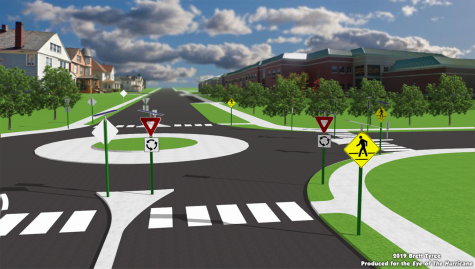
East Street @ Lincoln Avenue: Roundabout
The next intersection I highlighted above is East Street @ Lincoln Avenue, seen on the left. Under this design, the intersection would be transformed into a single-lane roundabout with an apron at the median for school buses and semi-trucks. One option featured in my designs are solar-powered, LED yield signs and pedestrian crossing signs. Going westbound on Lincoln Avenue, drivers have the option to go into one of two lanes, the rightmost lane is for right turns and straight movements only for the upcoming intersection at Highland Avenue, while the leftmost lane being for left turns only.
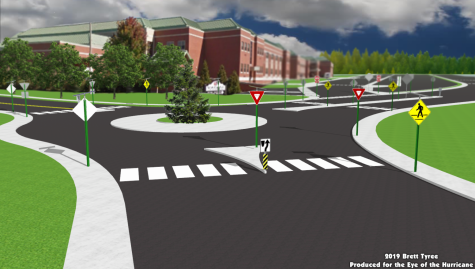
East Street @ Hurricane Drive: Roundabout
This intersection can be potentially dangerous during dismissal times as it is a blind intersection from Hurricane Drive. Currently, it is a one-way stop, for Hurricane Drive only. The exit of the school parking lot is also located very close to this intersection. The best option for this intersection is to install a single-lane roundabout with a truck apron at East Street @ Hurricane Drive. Also included is the creation of a concrete median on Hurricane Drive from the roundabout until beyond the exit for the school parking lot. The parking lot would be exit-only at this location. No left turns would be permitted from the parking lot, and no turns would be allowed into the parking lot. There would be stop signs on Hurricane Drive and at the parking lot exit, and cars will not be required to yield to buses, as they are required to currently. LED lights and solar panels are recommended at this intersection on the pedestrian and yield signs.
Lincoln Avenue @ Rhodes Place Roundabout
This intersection is the nearest to the sixth-grade entrance to the high school, close to a very congested parking lot. It is currently a two-way stop, with westbound traffic not being required to stop. The solution in mind is a single-lane roundabout with a median apron. LED yield and pedestrian crossing signs are also included, but optional.
Highland Avenue @ Wallace Avenue Roundabout
If a traffic light stays at this intersection, there would be only about 20 car lengths between this traffic light and my proposed one at Lincoln Avenue. This would have to call for a roundabout, to keep traffic continuously flowing. There would be a truck apron in the median, with LED yield and pedestrian crossings included, but optional. Also included is that Reis Street at Highland Avenue would have to be right-turn only.
Other Lighted Intersections Nearby
The intersections of Highland Avenue @ Park Avenue, Mill Street @ Falls Avenue, Mercer Street @ Falls Avenue, and Mercer Street and North Street do not have pedestrian signals, despite the amount of pedestrian traffic traveling through them. It can cause a potentially dangerous situation, especially during mornings and evenings when there may be a sun glare on the lights. The best solution would be to add new LED traffic lights to these intersections, with pedestrian signals, similar to that of the proposed traffic light at Highland Avenue @ Lincoln Avenue.
Analysis of Above & Conclusion
One thing you may notice about these intersections is that they are being designed with cost-efficiency, and most importantly, safety in mind. I purposefully added roundabouts at only intersections that buildings would not need to be demolished in order to construct a roundabout. This is in order to keep the amount of land that would need to be purchased through eminent domain to a minimal, if even necessary at places. The four proposed roundabouts would cost no less than $600,000 and no more than $1,000,000 to install, according to estimates by the Federal Highway Administration. For the four proposed new traffic lights to be installed in the area, it would cost between $300,000 and $400,000 to install, according to estimates by the Arizona Department of Transportation. This adds up, including other miscellaneous costs, to between $1,000,000 and $1,500,000 to complete such a project.
Luckily, a majority of the funds required to build such an extensive project can likely be acquired through federal grants. The $6.1 million dual-lane roundabout and storm drain, lighting, and signage improvements in Meadville were funded entirely through federal funds, according to PennDOT. The best type of funding for this type of project is a public-private partnership through the U.S. Department of Transportation or PennDOT. This type of funding is being used on numerous projects throughout the state, such as the Southern Beltway near Pittsburgh and the PA Turnpike – Interstate 95 connector near Philadelphia.
The final major issue with installing brand new intersections around the high school is that all or most of the construction would need to be conducted while school is not in session for the summer. Construction during school days could cause great delays around the school, worse than it is currently. A project to this extent would need to be completed in phases, with only a few intersections being constructed at a time.
If action is taken towards solving the traffic issues at the school now, it will never be an issue again for decades in the future. I am a strong believer that we need to build new infrastructure today to help solve problems that may worsen in the future. If even just a few of the solutions I mentioned above are put into place, we may see great improvements in our commute times to and from school. Not only will it improve commute times, but it will also make the intersections around the school much safer, not only for cars but also for pedestrians. We need to solve this problem as soon as possible.



